MENDELIAN LAW
Mendelian laws of heredity did not come into the limelight until 1900 when three botanists—Hugo de Vries, Erich von Tschermak, and Carl Correns—began independently conducting similar experiments with plants and arrived at conclusions similar to those of Mendel.
- Mendelian law of segregation
- Mendelian law of independent assortment,
- and, Mendelian law of dominance.
Actually, Mendel himself did not postulate any genetical principle or laws. He simply gave conclusive theoretical and statistical explanations for his hybridization experiments in his research paper. However, it was Correns, who discover Mendel’s work and proposed these fundamental laws. Further, he decided to give credit to his work and, thus, named these laws as “Mendelian laws”.
JOHANN GREGOR MENDEL
Johann Mendel, the father of genetics, was born on July 22, 1822, in Heinzendorf in Austrian Silesia. He graduated from the Gymnasium in 1840. In October 1843, Mendel was admitted to the Augustinian monastery at Brunn in Moravia where he took the name Gregor as a novice. Besides performing his other duties, he took a keen interest in natural sciences.
He conducted breeding experiments from 1856 to 1863. He delivered his first lecture on pea experiments to Brunn Natural Science Society on February 8, 1865. Although, Mendel’s paper from these lectures was published in 1866.
Reasons for his experimental success (mendelian law)
Mendel’s approach to the study of heredity was effective for several reasons.
- he chose pea plant for his experiment, which offered clear advantages for genetic investigation. As compared with some other plants, peas grow relatively rapidly. Thus, it completes an entire generation in a single growing season.
- a large number of varieties of peas was also crucial. Because these varieties differed in various traits and were genetically pure. Mendel was, therefore, able to begin with plants of variable, known genetic makeup.
- further, Mendel’s success is due to the seven characteristics that he chose for study. He avoided characteristics that display a range of variation. Instead, he focused on those that exist in two easily differentiated forms. For example, white versus grey seed coats, round versus wrinkled seeds, green verses yellow pod colour, etc.,
- Besides these contrasting characters, the pea plant is a very satisfactory material for the hybridization experiments due to its flower structure. The flowers of pea plants are so constructed that the pollens of a flower normally fall on the stigma of the same flower and, thus, affects self-pollination or self-fertilization.
- Finally, Mendel was successful because he adopted an experimental approach and interpreted his results by using mathematics. Mendel formulated hypotheses based on his initial observations and then conducted additional crosses to test his hypotheses.
Besides his experimental success, his remarkable piece of work remained unattended and unappreciated up to 1900.
Reasons for neglect of Mendel’s work
- at that time, the biologist’s were preoccupied with speculation concerning Darwin’s theory of evolution which appeared in 1859.
- his journal in which Mendel published his results was insignificant.
- the professional biologists of the nineteenth century did not think in a statistical manner that Mendel introduced in the study of hybridization.
- Further, Mendel himself made his work known only to some of the most famous hybridizers of his time, but not to the younger generation of scientists who were perhaps less prejudiced against new ideas.
This neglect of his work and other economical and physical hazards made him greatly disappointed and bitter. Due to it, his health progressively degenerated. Moreover, he became far too obese and began to suffer from dropsy due to heart and kidney failure. The pioneer of classical genetics, thus, died unknowingly, on 6th January 1884.
Rediscovery of Mendel’s work
Mendel’s research paper remained dormant and unnoticed by the scientific world until 1900. During these intervening thirty-four years, many developments occurred in biology which prepared the way for the rediscovery of Mendel’s work.
At the beginning of the 20th century, three botanists, namely Hugo de Vries, Carl Correns, and Erich von Tschermak, independently drawn the conclusions like Mendel. Later these botanists came across the research paper of Mendel and rediscovered it in 1900. Mendel’s original paper was republished in 1901. Further, Bateson confirmed Mendel’s work by a series of hybridization experiments.
GENETIC TERMS USED
Before I proceed further, let me introduced you with the commonly used terms in genetics. Please go through these terms thoroughly so that you will fully understand the topic… I am also providing you with a table for that.
- Gene: it a unit of hereditary information that occupies a fixed position (locus) on a chromosome. In other words, it is an inherited factor that determines a characteristic.
- Allele: it is one of two or more alternate forms of a gene. Alleles may occur in pairs, or there may be multiple alleles affecting the expression of a particular trait. For instance, in Mendel’s crosses, seed shape will be determined by a gene that exists as two different alleles: one allele encodes round seeds and the other encodes wrinkled seeds.
- Locus: all alleles for any particular gene are present at a specific place on a chromosome. This is the locus for that gene.
- Genotype: the genotype is the set of alleles that an individual organism possesses.
- Phenotype: it is the appearance of a characteristic. A phenotype can refer to any type of characteristic, i.e., physical, physiological, biochemical, or behavioural. For example, the condition of having round seeds is a phenotype.
- Heterozygous: an individual organism possessing two different alleles at a locus is a heterozygous condition.
- Homozygous: an individual organism possessing two of the same alleles at a locus.
- F1 generation: the population obtained by crossing plants showing contrasting characters is the F1 generation. For example, if I cross two plants that have characteristics of tall and dwarf, the outcome will be the F1 generation.
- F2 generation: the progeny of F1 plants then obtained by self-fertilization forms the F2 generation. Similarly, F3, F4, etc., generations can also be obtained.
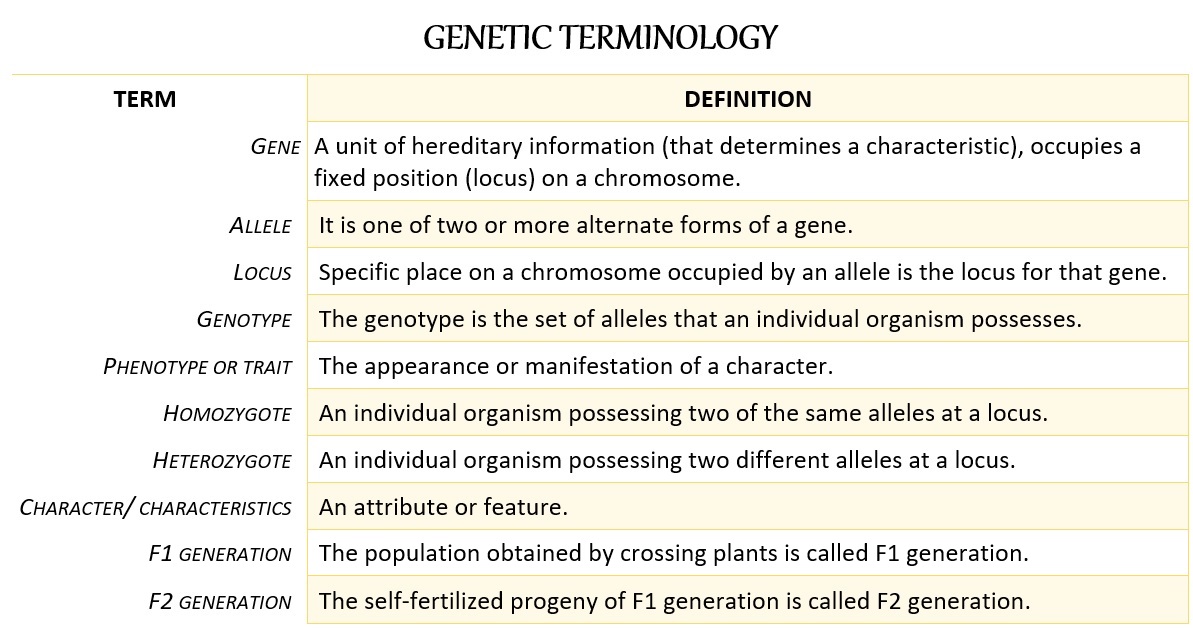
HOW MENDEL CONDUCT THE EXPERIMENT?
For his experiment, he chose seven contrasting characters of the pea plant. one alternative trait was used as female and those with the other alternative as male.
Here, I am going to interrupt your reading for a minute. As I can’t resist myself to tell you that this (Mendelian laws)…. was… the… MOST… interesting topic for me when I was in secondary school. Moreover, I am enjoying writing it and I hope you will find it pretty interesting too…
Now, you can peacefully move to your reading part… I will try not to interrupt you again…
I am listing all the seven characters used in mendelian laws below if you are keen to know about them…
List of characters:
- stem: tall or dwarf
- cotyledons: green or yellow
- seed: round or wrinkled
- seed coat: coloured or colourless
- pod
- ripe pod: inflated(dominant) or constructed(recessive)
- unripe pod: green or yellow
- flower position: axial or terminal
- flower colour: white or yellow
The experiment
As I mentioned earlier, the flowers of pea plants are so that the pollens of a flower normally fall on the stigma of the same flower and, thus, affects self-pollination or self-fertilization. For cross-pollination, he removed anthers from the flower in the bud stage before their maturity (emasculation). Meanwhile, he protects the stigma from any foreign pollen by covering with a bag. After that, he brought the pollen(at the dehiscence stage) from the male parent and dusted on the feathery stigma of the emasculated flower.
Mendel transferred the pollen to the flower with the help of a brush. At the time of such cross-pollination, the pollen should be mature and stigma should be receptive.
For each of seven pairs of characters, plants with one alternative trait were used as female and those with the other alternative as male. Reciprocal crosses were also made.
Reciprocal crosses mean that if he used one trait as a male in one cross, he used the same trait as a female in another cross.
How Mendel obtained pure(homozygous) varieties for his experiment?
It was necessary for Mendel to rear a genetically pure variety of pea plants for a single character for getting the exact results in the breeding experiments. For this, Mendel adopted self-fertilization technique.
For instance, to get pure character for tallness, he self-fertilized a tall pea plant for many generations until the resulted offsprings always produced only tall plants. Likewise, he got a genetically pure variety for dwarf pea plants. Mendel cross-pollinated these two varieties of pea plants which were differing in a pair of contrasting characters, viz., tallness and
When he made observations on the offspring of F1 generation he found only tall plants. He allowed the self-pollination in the offsprings of F1 generation and made further observations on the offsprings of
Result
- He was astonished to note both tall and dwarf offspring appear in the F2 generation. This showed him that the character of
dwarfness disappeared in F1 generation but again reappeared in the second generation. - Further, the tall and dwarf plants of
F2 generation were always in the ratio of 3:1 (3tall : 1 dwarf). - He self-pollinated the dwarf offsprings of F2 generation and found only dwarf plants in
F3 generation. - But when he self-pollinated the tall plants of F2 generation then he found that one-third (1/3) tall plants yield only tall plants in
F3 generation, while rest two-third (2/3) tall plants yield tall and dwarf plants in the ratio of 3:1.
So, this is all I can tell you about his experiment, now time to move on to the Mendelian laws of heredity or inheritance…
MENDELIAN LAW OF SEGREGATION
Mendel’s first law–the law of segregation or Mendelian law of segregation is also known as the law of purity of gametes. The principle of segregation states that each individual diploid organism possesses two alleles for any particular characteristic. These two alleles segregate (separate) when gametes will form, and one allele goes into each gamete. Furthermore, the two alleles segregate into gametes in equal proportions.
In simple words, the Mendelian law of segregation states that all living organism on earth has two copies of each gene. They inherit one copy of each gene from their parents. When a gamete form, one copy of the gene will come from each parent.
Mendelian law of segregation is universal in its application and it occurs in both plants and animals.
LAW OF DOMINANCE
The law of dominance states that when two different alleles are present in a genotype, only the dominant allele is observed in the phenotype.
In other words, hybrid offsprings will only inherit the dominant trait in the phenotype. The alleles that are suppressed are called as the recessive traits while the alleles that determine the trait are known as the dormant traits.
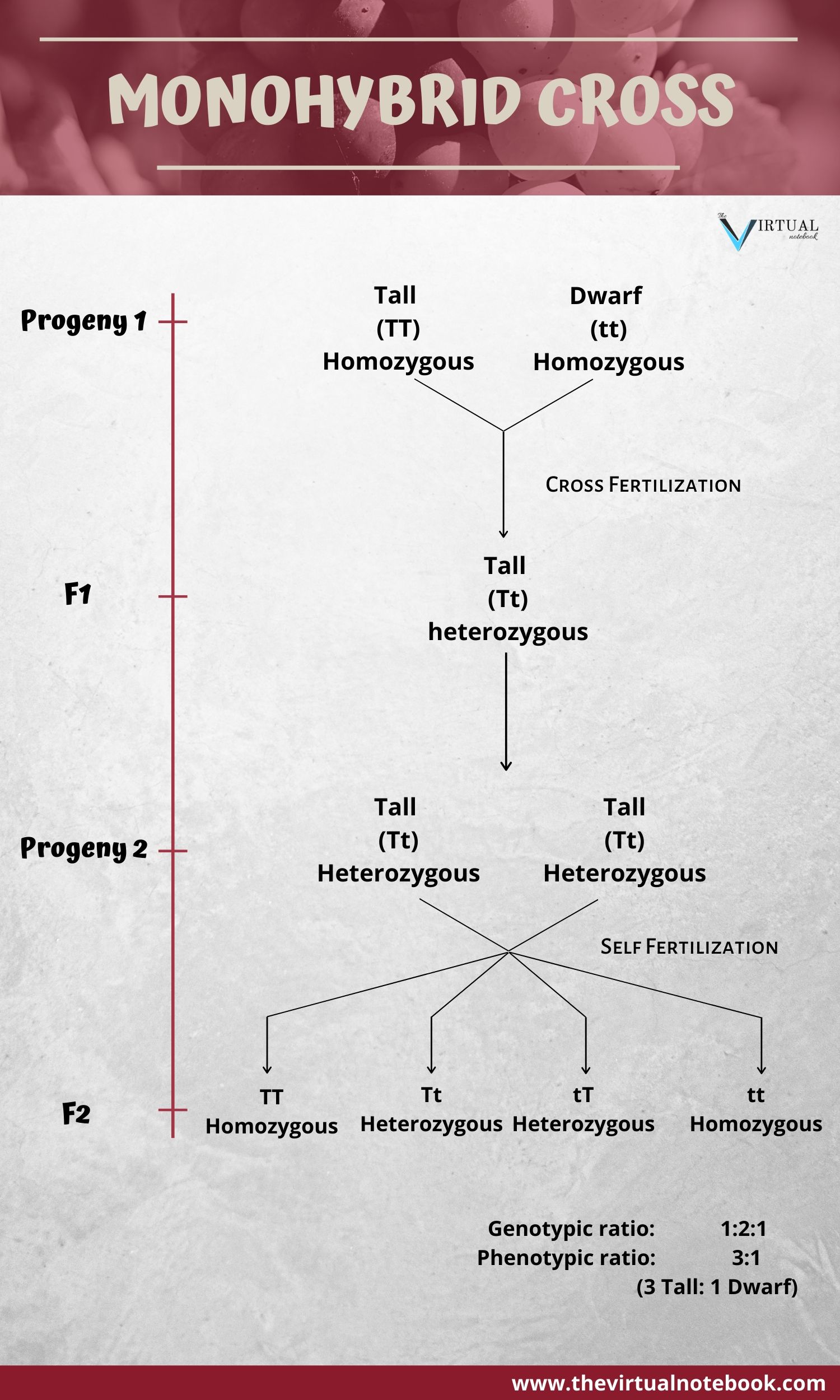
Variation in the law of dominance
In some cases, the phenotypes of heterozygotes are different from either of the homozygotes. Depending upon expression of gene, it can be of two types:
- Incomplete Dominance
- Codominance
Incomplete Dominance
It occurs when a heterozygote dominant allele does not completely mask the phenotypic expression of the recessive allele and there occurs an intermediate phenotype in the heterozygote. This is called incomplete dominance.
Examples
For instance, when a red-flowered pea plant (RR) is crossed with white-flowered pea plant (
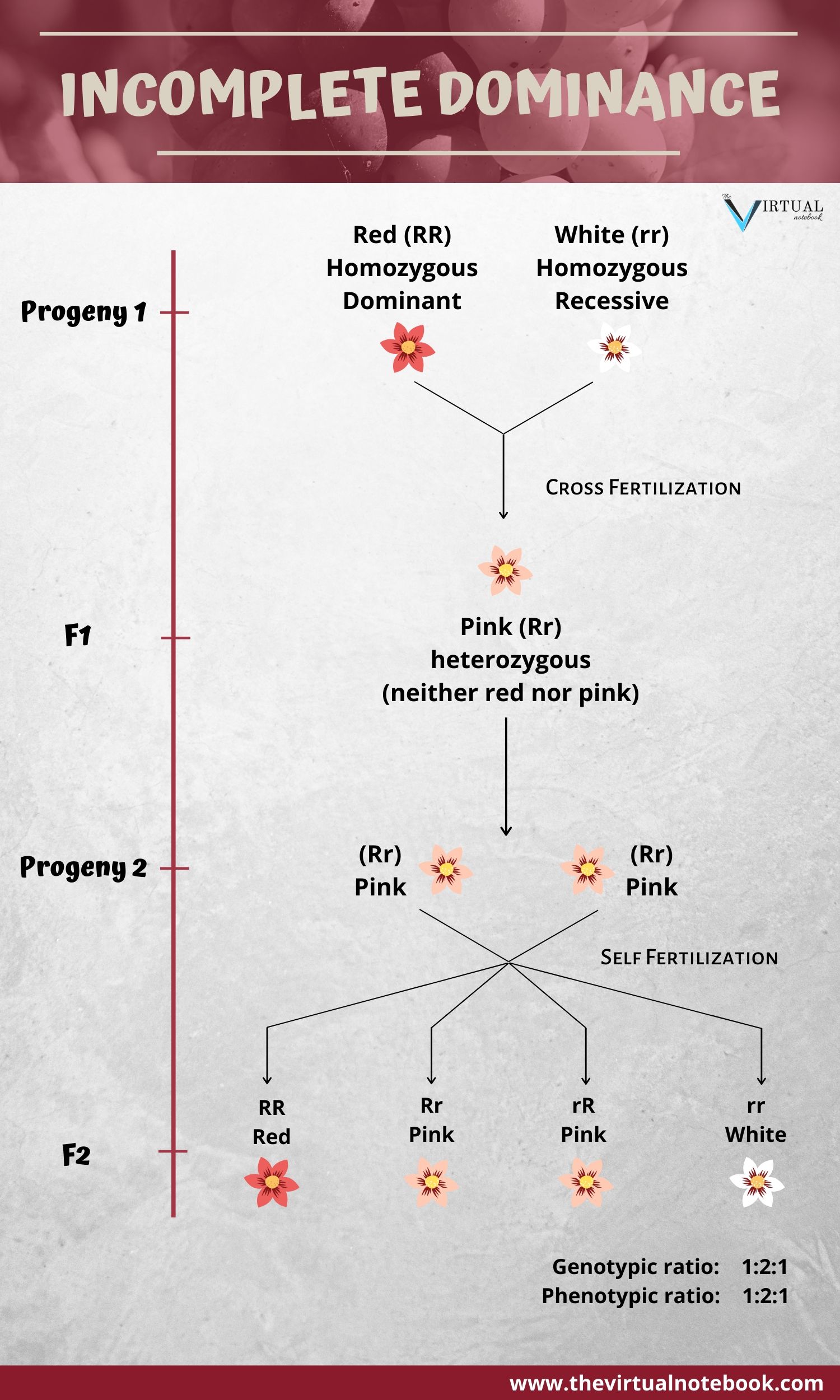
Here, it shows that the gene for red colour could not completely dominate the gene for white colour. In such a case,
Another examples of incomplete dominance are four-o’clock plants (Mirabilis jalapa) or snapdragons (Antirrhinum majus).
Codominance
Sometimes both alleles of a gene in a heterozygote lack the dominant and recessive relationship, i.e., each allele is capable of some degree of phenotypic expression. In other words, codominance is no dominance at all, the heterozygote showing the phenotypes of both homozygotes. Hence, heterozygote genotype gives rise to a phenotype distinctly different from either of the homozygous genotypes.
Examples
The coat colour of the Shorthorn breed of cattle represents a classical example of codominance. When a cattle of the red coat (CR CR) is crossed with the cattle of a white coat (CWCW), the F1 heterozygote or hybrid appears to possess roan coat (CRCW). In roan coat, the red and white hairs occur in definite patches but no hair has an intermediate colour of red and white.
Another example is M-N blood group I humans. Here, three blood groups are possible–M, N and MN. Blood groups actually represent the presence of an immunological antigen on the surface of red blood cells.
For immunoglobulins, see: Immunoglobulins structure and functions
LAW OF INDEPENDENT ASSORTMENT
When the parents differ from each other in two or more pairs of contrasting characters or factors then the inheritance of one pair of factors is independent to that of the other pair of factors. The law of independent assortment is clearly visible in dihybrid crosses.
Dihybrid cross
Mendel crossed a homozygous (yellow round seeds) pea plant with the homozygous pea plant(green wrinkled seeds). The F1 hybrids appear to have yellow round seeds. When he crossed the F1 hybrids, they produced four types of seeds in the ratio of 9:3:3:1.
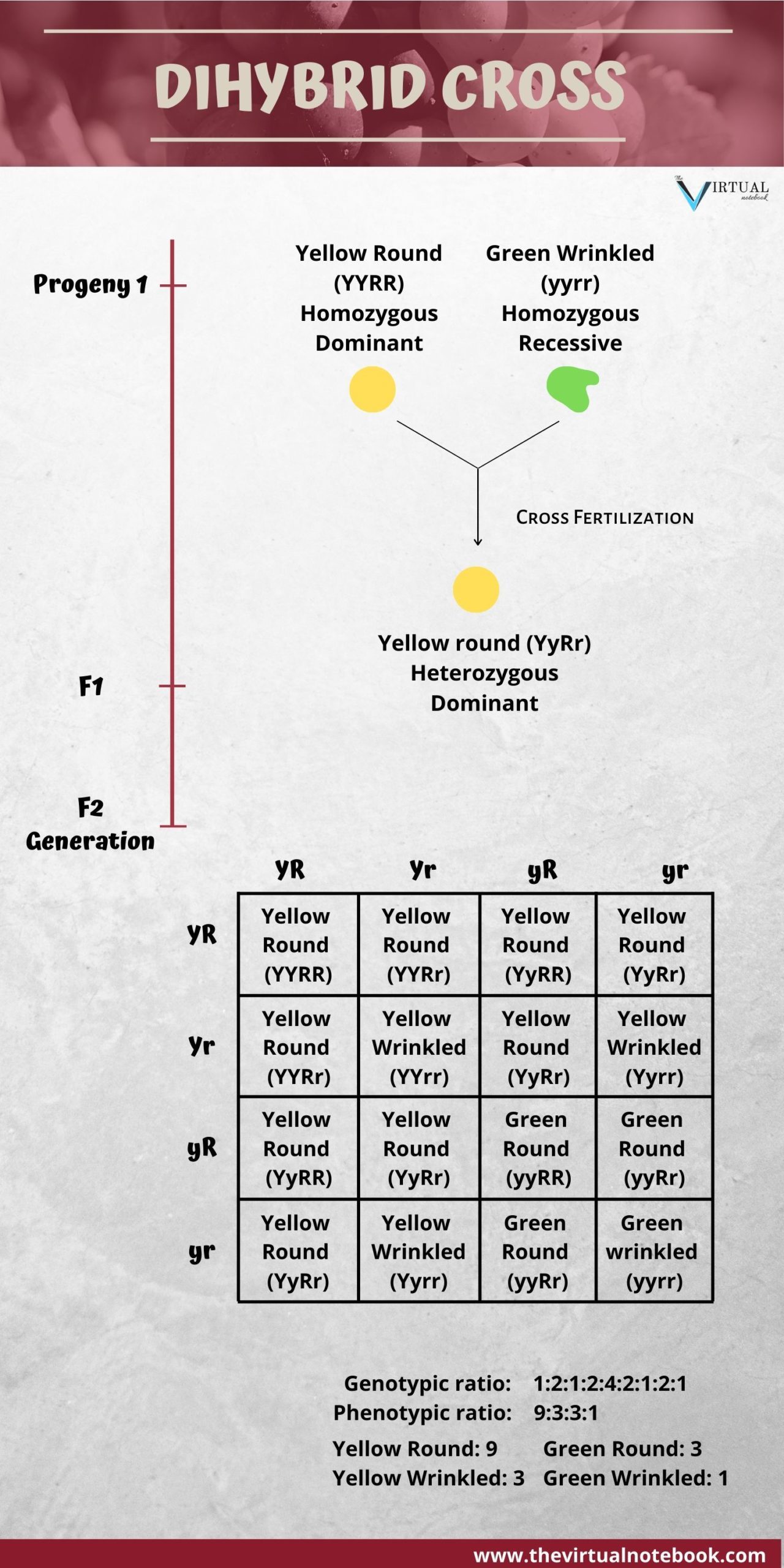
Besides getting the ratio of 3:1 of the monohybrid crosses Mendel got the ratio of 9:3:3:1.
These results have proved the law of independent assortment and showed that each pair of contrasting characters behaves independently and bears no permanent association or relation with a particular character.
SOURCES AND LINKS
Cell biology, genetics, molecular biology, evolution and ecology by P.S Verma and V.K. Aggarwal, S. Chand and company Ltd., Genetics: chapter no. 3
Genetics: A conceptual approach, fourth edition by Benjamin A. Pierce; W H Freeman and company, chapter no. 3 – Basic principles of heredity
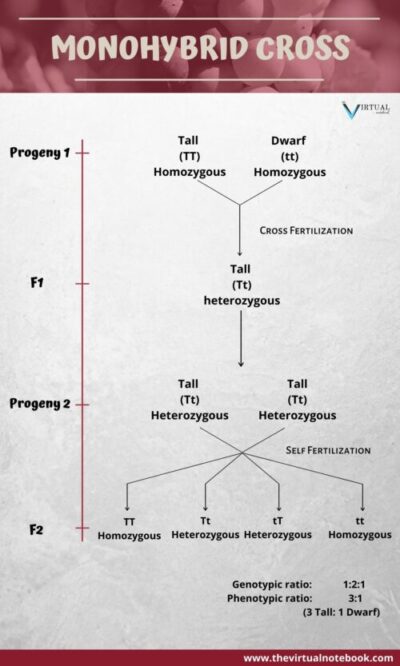
Thanks